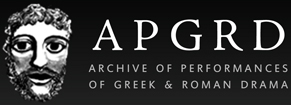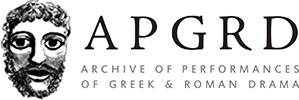A guest post by undergraduates from the University of Nebraska-Lincoln
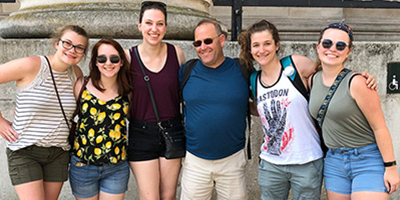 We were delighted to welcome a group of five undergraduates from the University of Nebraska-Lincoln to work us on their own ebook about Sophocles' Antigone, inspired by the methods and production of the APGRD's open-access interactive/multimedia ebooks on the reception histories of Euripides' Medea and Aeschylus' Agamemnon.
We were delighted to welcome a group of five undergraduates from the University of Nebraska-Lincoln to work us on their own ebook about Sophocles' Antigone, inspired by the methods and production of the APGRD's open-access interactive/multimedia ebooks on the reception histories of Euripides' Medea and Aeschylus' Agamemnon.
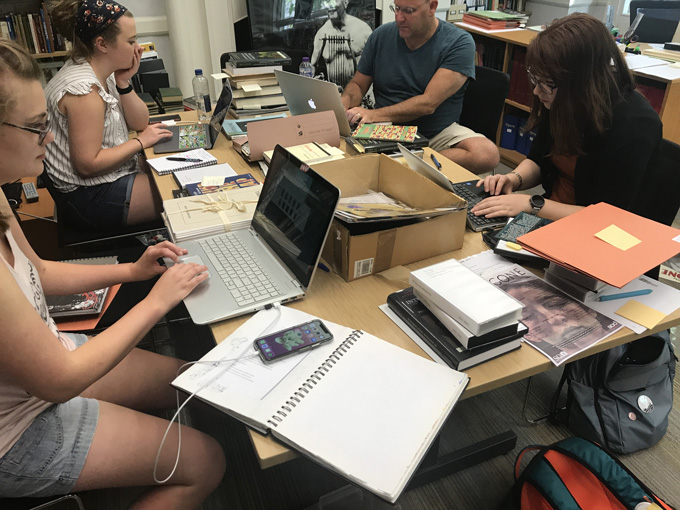 We are a group of five undergraduates from the University of Nebraska-Lincoln and we are working with the Archive of Performances of Greek and Roman Drama (APGRD) to create a multimedia ebook about Sophocles’ Antigone, the latest addition to an ongoing series started by the Archive’s team. Despite UNL's active art culture and excellent research library, there was only so much we could do in our effort to access primary artifacts for modern performances of Greek drama. Most of our research thus needed to take place online. Such research was not as comprehensive as we had hoped, so when we were offered the opportunity to visit the APGRD in the Classics Faculty in Oxford, we leapt at the opportunity.
We are a group of five undergraduates from the University of Nebraska-Lincoln and we are working with the Archive of Performances of Greek and Roman Drama (APGRD) to create a multimedia ebook about Sophocles’ Antigone, the latest addition to an ongoing series started by the Archive’s team. Despite UNL's active art culture and excellent research library, there was only so much we could do in our effort to access primary artifacts for modern performances of Greek drama. Most of our research thus needed to take place online. Such research was not as comprehensive as we had hoped, so when we were offered the opportunity to visit the APGRD in the Classics Faculty in Oxford, we leapt at the opportunity.
Through the generosity of the APGRD and the Undergraduate Creative Activities and Research Experience (UCARE) program at the University of Nebraska, our team was able to make a fully-funded trip to Oxford this past June to access the APGRD’s collection. Before our arrival, we had already undergone a year of ebook and archival training, for the most part delivered via Skype by members the Oxford APGRD team responsible for the Medea ebook. We learned the basics of how to create a visually appealing ebook, maximize and focus our research, and establish ways to obtain copyright permissions.
Our week on the ground at the Archive in Oxford, however, contained invaluable learning opportunities and research experiences that simply could not be equalled over the internet. All five of us on the trip consider it a formative part of our undergraduate experience. Before our arrival, we were eager to have the opportunity to do archival research in the largest collection of contemporary performances of ancient drama and spent a great deal of time planning for our visit so as to maximize our time. During that week, we were able to gather more - and far better - information in the limited time we had there than we had through several months of online research. We accessed hundreds of performances from dozens of cultures, which we then filtered and incorporated into our ebook’s living storyboard. This sole week in the archive was the most influential step in bringing our Antigone ebook from a mere concept into what now seems like an achievable finished product.
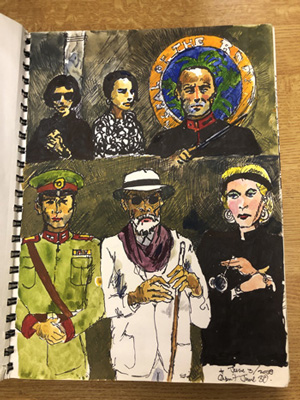 The Archive contains an abundance of impressive and intriguing material from around the world, and it is quite difficult to select any one piece as the most important for us. Nevertheless, at Professor MacIntosh's request, and after some discussion, we came up with the one artifact that had the highest impact on our team. Looking back, we agreed that one object caught our attention from first glance and continued to surprise us with its uniqueness and importance: a sketchbook (right) for the designs that Derek Walcott made for a production of an opera version of Seamus Heaney’s The Burial at Thebes that the APGRD through its Onassis Programme co-produced with Oxford Playhouse and London’s Globe Theatre in 2008. Our year of previous research had given us familiarity with Heaney's translation, but at this point we knew nothing of Derek Walcott. That is until our research advisor, Dr. Michael Lippman, informed us of who he was and of his overall significance, so it took us a bit of time just to realize the importance of the object that what we had in our hands. Once we did, the significance of this find became clear. Walcott, we now know, is primarily known to the Classics community for his poetry, specifically his epic poem Omeros, so finding sketches seemed so unexpected. This sketchbook is unpublished, and the Archive contains the original artwork — marker drawings on paper, pasted into the book — so just our encounter with such an important document had a personal and powerful effect on us all. Being able to hold this book and look through the drawings while learning this unusual find that we could now help share with a larger audience was a wonderful experience.
The Archive contains an abundance of impressive and intriguing material from around the world, and it is quite difficult to select any one piece as the most important for us. Nevertheless, at Professor MacIntosh's request, and after some discussion, we came up with the one artifact that had the highest impact on our team. Looking back, we agreed that one object caught our attention from first glance and continued to surprise us with its uniqueness and importance: a sketchbook (right) for the designs that Derek Walcott made for a production of an opera version of Seamus Heaney’s The Burial at Thebes that the APGRD through its Onassis Programme co-produced with Oxford Playhouse and London’s Globe Theatre in 2008. Our year of previous research had given us familiarity with Heaney's translation, but at this point we knew nothing of Derek Walcott. That is until our research advisor, Dr. Michael Lippman, informed us of who he was and of his overall significance, so it took us a bit of time just to realize the importance of the object that what we had in our hands. Once we did, the significance of this find became clear. Walcott, we now know, is primarily known to the Classics community for his poetry, specifically his epic poem Omeros, so finding sketches seemed so unexpected. This sketchbook is unpublished, and the Archive contains the original artwork — marker drawings on paper, pasted into the book — so just our encounter with such an important document had a personal and powerful effect on us all. Being able to hold this book and look through the drawings while learning this unusual find that we could now help share with a larger audience was a wonderful experience.
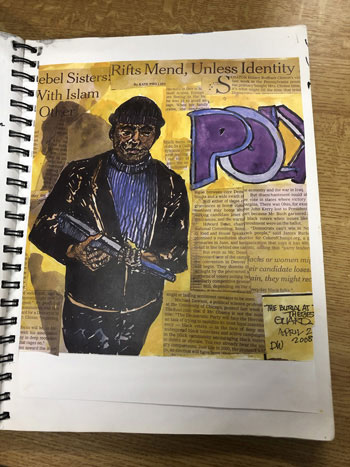 The sketches themselves are visually stunning, highly thought-provoking, and eclectic. Some are colored while others are black and white. One sketch is colored over newspaper clippings which address contemporary world politics. These sketches add a personal and dynamic touch to the text. In the text of Heaney's play, he juxtaposes ancient and modern by utilizing the heritage and landscape of Northern Ireland and setting it side-by-side with an ancient classic. In the accompanying sketches, Walcott employs this same interplay by showcasing the style of the characters’ clothes. The main characters’ attire is modern, and thus contrasts with the chorus, represented by a single dancer dressed in decorative ancient Greek armour. The guard’s modern machine gun evokes modern warfare, while the dancer’s weapons and armour reflect the lingering ancient Greek elements.
The sketches themselves are visually stunning, highly thought-provoking, and eclectic. Some are colored while others are black and white. One sketch is colored over newspaper clippings which address contemporary world politics. These sketches add a personal and dynamic touch to the text. In the text of Heaney's play, he juxtaposes ancient and modern by utilizing the heritage and landscape of Northern Ireland and setting it side-by-side with an ancient classic. In the accompanying sketches, Walcott employs this same interplay by showcasing the style of the characters’ clothes. The main characters’ attire is modern, and thus contrasts with the chorus, represented by a single dancer dressed in decorative ancient Greek armour. The guard’s modern machine gun evokes modern warfare, while the dancer’s weapons and armour reflect the lingering ancient Greek elements.
Our discovery of this artifact offered a completely different perspective on The Burial at Thebes. To us, even though we can and will share many of our other discoveries, this one best exemplified the necessity of archival research. Without the Archive of Performances of Greek and Roman Drama and their support throughout the project, our team would never have known about these remarkable sketches. Without a doubt (if at all possible), we plan on highlighting Walcott’s sketches in our forthcoming ebook because they will show readers a unique interpretation of Antigone from several different perspectives and cultures simultaneously, and they depict precisely the analogy between modern and ancient we are trying to achieve in our ebook.
Photographs of sketchbook held in APGRD Collections, all designs © Derek Walcott
